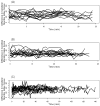A comparison of SNAP II and bispectral index monitoring in patients undergoing sedation
- PMID: 20586747
- PMCID: PMC2909341
- DOI: 10.1111/j.1365-2044.2010.06408.x
A comparison of SNAP II and bispectral index monitoring in patients undergoing sedation
Abstract
Clinical signs and patients' verbal responses have traditionally been used to assess patients' comfort and the depth of sedation. Recently, level-of-consciousness monitors have been used to guide sedation. The SNAP II(c) is a single-lead electroencephalogram device that displays a SNAP(c) Index - a derived value based on both high and low frequency electroencephalogram signals. Much of the current clinical research on monitoring during sedation involves the bispectral index monitor. We compared simultaneous readings recorded by the SNAP II and bispectral index during sedation in 51 consecutive patients undergoing surgery. The anaesthesia team was blinded to the SNAP II and bispectal index values. Concurrent SNAP II and bispectral index readings displayed similarly-shaped trajectories during sedation, but further studies are needed to establish the routine clinical utility of both these monitors.
Figures


Similar articles
-
Cerebral state monitor, a new small handheld EEG monitor for determining depth of anaesthesia: a clinical comparison with the bispectral index during day-surgery.Eur J Anaesthesiol. 2006 Mar;23(3):208-12. doi: 10.1017/S0265021505002206. Eur J Anaesthesiol. 2006. PMID: 16430792 Clinical Trial.
-
Bispectral Index Monitoring: validity and utility in pediatric dentistry.J Clin Pediatr Dent. 2014 Summer;38(4):366-9. doi: 10.17796/jcpd.38.4.17j63w8013614933. J Clin Pediatr Dent. 2014. PMID: 25571691
-
Bispectral index (BIS) monitoring of intravenous sedation for dental treatment.SAAD Dig. 2014 Jan;30:7-11. SAAD Dig. 2014. PMID: 24624517
-
[Bispectral analysis of the electroencephalogram: a new method for recording the level of consciousness during anaesthesia].Ned Tijdschr Geneeskd. 2004 Jun 26;148(26):1276-80. Ned Tijdschr Geneeskd. 2004. PMID: 15279209 Review. Dutch.
-
Towards evidence-based emergency medicine: best BETs from the Manchester Royal Infirmary. BET 1: the use of bispectral index monitoring (BIS) in conscious sedation.Emerg Med J. 2015 May;32(5):414-5. doi: 10.1136/emermed-2015-204758.1. Emerg Med J. 2015. PMID: 25890941 Review.
Cited by
-
Sedation for critically ill or injured adults in the intensive care unit: a shifting paradigm.Drugs. 2012 Oct 1;72(14):1881-916. doi: 10.2165/11636220-000000000-00000. Drugs. 2012. PMID: 22950534 Review.
-
The SNAP index does not correlate with the State Behavioral Scale in intubated and sedated children.Paediatr Anaesth. 2013 Dec;23(12):1174-9. doi: 10.1111/pan.12258. Epub 2013 Sep 19. Paediatr Anaesth. 2013. PMID: 24103039 Free PMC article.
-
A Prospective, Multicenter, Single-Blind Study Assessing Indices of SNAP II Versus BIS VISTA on Surgical Patients Undergoing General Anesthesia.JMIR Res Protoc. 2017 Feb 3;6(2):e15. doi: 10.2196/resprot.6741. JMIR Res Protoc. 2017. PMID: 28159731 Free PMC article.
References
-
- De Jonghe B, Cook D, et al. Using and understanding sedation scoring systems: a systematic review. Intensive Care Medicine. 2000;26:275–85. - PubMed
-
- Anderson RE, Jakobsson JG. Cerebral state monitor, a new small handheld EEG monitor for determining depth of anesthesia: a clinical comparison with the Bispectral index during day-surgery. European Journal of Anaesthesiology. 2006;23:208–12. - PubMed
-
- Jameson LC, Sloan TB. Using EEG to monitor anesthesia drug effects during surgery. Journal of Clinical Monitoring and Computing. 2006;20:445–72. - PubMed
-
- Turkmen A, Altan A, Turgut N, Vatansever S, Gokkaya S. The correlation between the Richmond agitation-sedation scale and Bispectral index during dexmedetomidine sedation. European Journal of Anaesthesiology. 2006;23:300–4. - PubMed
Publication types
MeSH terms
Grants and funding
LinkOut - more resources
Full Text Sources
Medical

